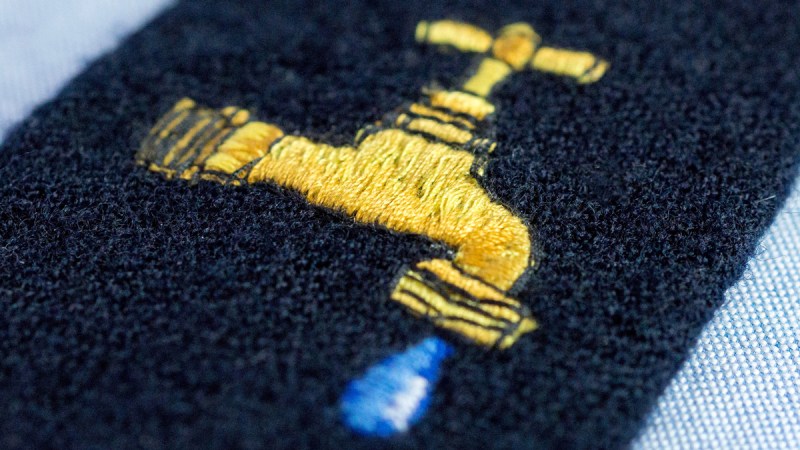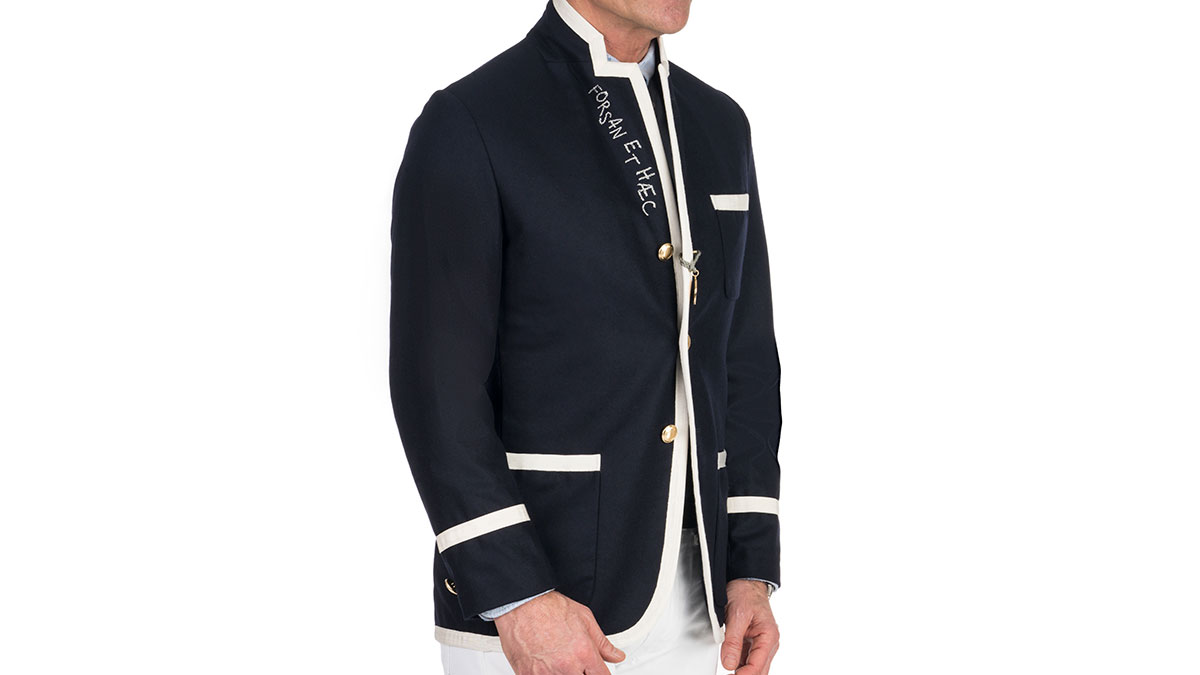Blazers have a rich history and that’s celebrated with the new menswear line Rowing Blazers by designer Jack Carlson who wrote a Buy Now about their origin and place in fashion history three years ago. Inspired by his research, he went on to create this fantastic new collection of jackets, shirts and accessories that reimagines these iconic looks for modern gents. It is sold direct to consumers online.
Carlson recently filled me in about his terrific new label…
What is the background of the line and what prompted you to launch it?
I spent a long time in the sport of rowing: nearly two decades, including three years on the U.S. national team, so I’ve been immersed in this world for a while. At the same time, I’ve also been interested in menswear and in heraldry (the study of symbols, badges and coats of arms) for a long time. This kind of brings all those interests together.
What are some of the key/your favorite blazers in it?
The navy topstitch blazer is key, because at first glance there’s nothing in-your-face “rowing” about it. Then you notice the single large cuff buttons; the perfect swoop of the three-roll-two silhouette (which the rowing blazer pioneered); the ventless back (vents are an innovation of riding, and a well-made single-breasted blazer looks better without!); the unlined but beautifully finished interior; the secret cross-stitched Latin embroidery under the lapel. To me, it’s the perfect navy blazer.
Another of my favorite pieces in our collection is the 8×3 double-breasted blazer, which is inspired by a blazer Prince Charles always wears. One never sees an 8×3 double-breasted blazer on the market, so we had to make one. With five cuff buttons, an oversized front button from a vintage die, and a perfect fit, it came out brilliantly.
And non-blazer pieces?
Our Bath Club Tie is key and is my go-to tie. I saw a tie like it on the wall at the Bear Inn, Oxford’s oldest pub. I did a little research and found out it was the tie for an informal club that existed from the 19-teens to the 1950s or so, and it signified that its wearer had “bathed” in one of the women’s colleges at Oxford.
It’s the perfect combination of history, irreverence and great design that epitomizes our brand. It’s handmade in New York from Japanese wool, and the faucet motif is satin-stitched, so it also speaks to the quality and attention to detail that we are all about.

How do you balance the collection’s old-fashion aesthetic with modern-day fashion?
Some things are just timeless. I’d throw blue Oxford-cloth button-downs (especially when they have the perfect collar roll), webbing belts, and the perfect blazer into that category too. But a lot of these timeless items are actually hard to find nowadays, because very few people are doing it well, doing it here in the U.S., and doing it with the proper historical understanding and attention to detail.
We are just creating those timeless pieces with that rigorous attention to detail, and also with a streak of creativity and irreverence, and suddenly it’s (apparently) fashion. I draw on my experiences working at the College of Arms (the UK government agency responsible for designing coats of arms), and doing a PhD in archaeology at Oxford for a lot of the inspiration, especially with regard to the motifs on our ties and hats.
Who is your customer?
People from all sorts of different backgrounds love what we’re doing. Menswear nerds love the research that has gone into everything we do and the quality of the construction and materials. The Japanese (we have a significant following in Asia) love the fact that our pieces are handmade in America. “Preppies” – and I hate that word – love that we are bringing back all-American staples with both a tremendous amount of respect and understanding and also with a sense of freshness and irreverence. Streetwear fanatics enjoy the cryptic Latin graffiti and funky graphics on our caps and badges.

How important was it to produce domestically?
For one thing, it’s important to us not to cut any corners. To do as much by hand as we can, and to be true to the details and construction techniques that went into the vintage blazers from the ’20s and ’30s hanging in our office. As designers, to work directly with the men and women actually sewing the garment. That’s extremely important to us, and making our pieces in New York allows us to do that. We are also supporting the effort to save Manhattan’s historic Garment District. But most importantly, we also believe that the craftsmen and -women making these pieces should enjoy great working conditions and the kind of real salaries their amazing work warrants.
What has been the best part about launching the line?
It has just been great to see people from all walks of life responding so positively to the collection. It’s gratifying after years of research and over two years of product development. When I flipped the switch and the site went live, I remember asking my girlfriend shortly thereafter “Did we get any orders yet?” And she said, “No, but we’ve only been live for three minutes and 12 seconds.” A few minutes later we received our first order, from someone none of us knew. By the end of the day we had almost sold out of hats and a few sizes/styles of shirts. That was so affirming.

Tell me about the inspiration to include sandpaper with the shirts…
I had an Oxford cloth button-down shirt that I practically lived in. I wore it while excavating in Italy; hiking in Patagonia; celebrating at Henley after exhilarating victories; drowning my sorrows at Henley after gutting losses; I wore it to elegant dinners and to many more greasy spoons.
The collar and cuffs wore down and frayed with years of use, and seams started to come apart. And it just felt right. We’ve recreated that feeling – without overdoing it, but also without kidding ourselves, with just the right amount of tongue-in-cheek. That’s why we include a piece of sandpaper with each shirt, together with a withering quote by the historian, author and public intellectual Edward Said about his Princeton roommates who used to sand the collars of their blue button-downs.
… and the badges on certain pieces….
The badges are inspired by my archaeological studies and my background in heraldry. I very consciously didn’t want to do expected motifs like crossed oars, phony “crests,” monograms, crowns. I wanted to be more cryptic, but also more meaningful. The thunderbolt motif is from my own coat of arms, for example. The ship is a heraldic lymphad, with its sails rolled up and its oars in action: a reference to our company motto – DESTITVTVS VENTIS REMOS ADHIBE, “If the wind will not serve, take to the oars.”

Where do you see Rowing Blazers going in the future?
We’ll be expanding into a few other categories, in some cases through some exciting collaborations including a T-shirt and sweatshirt collaboration with Merz b. Schwanen, a very historic knitwear manufacturer in Germany, and expanding our retail footprint in Asia, where we’ll be going into two of the best menswear stores on the planet: United Arrows & Sons in Harajuku, Japan, and Hotel V in Taiwan. We’ll also be sticking to our classic pieces: the best blazers in the world and the perfect Oxford shirt.
What, in your opinion, makes a great blazer?
The original blazer was the hoodie of its time; it was a casual piece of clothing that oarsmen would wear on their way down to practice in the morning, and that they might keep on while they warmed up – or on especially chilly days, while they raced. They grew attached to these jackets and began wearing them to social events and around their colleges. But I think a great blazer pays homage to these origins. It should be unlined; it should have that perfect swoop of the lapel that comes with the 3-roll-2 silhouette; and it should have patch pockets (with either a swelled-seam topstitch or a hidden stitch) and metal buttons.



